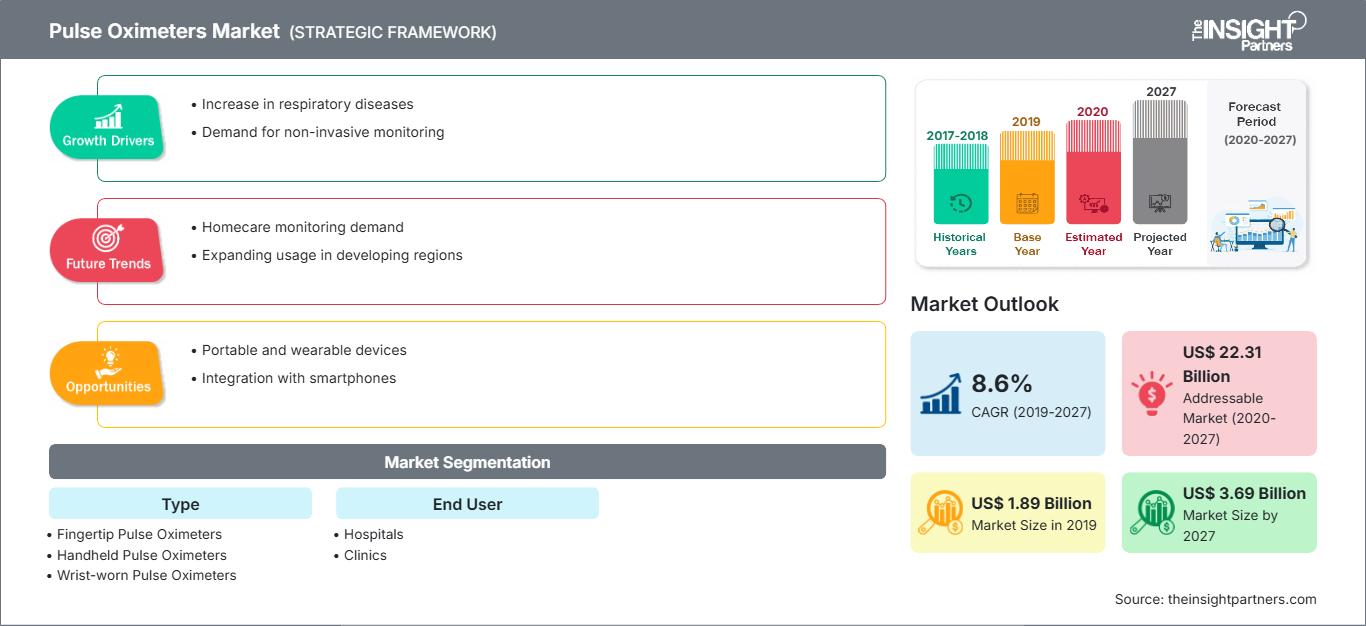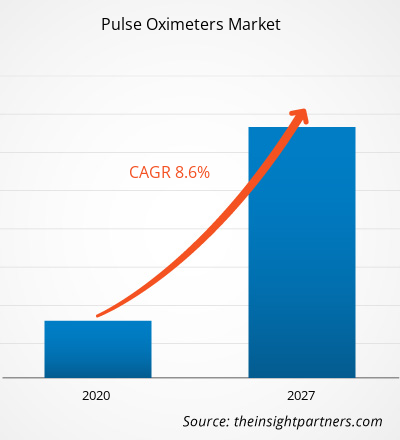El mercado de oxímetros de pulso se valoró en 1.892,00 millones de dólares estadounidenses en 2019 y se prevé que alcance los 3.693,92 millones de dólares estadounidenses en 2027; se espera que crezca a una tasa de crecimiento anual compuesta (TCAC) del 8,6% durante el período 2020-2027.
El oxímetro de pulso es un dispositivo no invasivo que se utiliza para monitorizar la saturación de oxígeno en sangre. Es un pequeño dispositivo con forma de pinza que se coloca en el dedo o el lóbulo de la oreja. Se utiliza principalmente en cuidados intensivos, quirófanos, urgencias y con pacientes a gran altitud para evaluar su oxigenación y determinar si necesitan oxígeno suplementario. Además, los oxímetros de pulso son útiles para pacientes con problemas cardíacos, respiratorios y enfermedad pulmonar obstructiva crónica (EPOC).
Perspectivas del mercado
El aumento de la prevalencia de enfermedades respiratorias impulsa el crecimiento del mercado
La creciente prevalencia de las enfermedades respiratorias se relaciona con la disminución del diámetro de la luz de las vías respiratorias superiores con la edad. Un gran porcentaje de la población mundial padece diversos tipos de enfermedades respiratorias. El tabaquismo, los factores genéticos y las infecciones se encuentran entre los factores comunes que causan estas enfermedades. La enfermedad pulmonar obstructiva crónica (EPOC), la apnea del sueño, las arritmias cardíacas, las cardiopatías isquémicas, la diabetes, la hipertensión y el asma son algunas de las afecciones que suponen una carga significativa para los sistemas de salud pública en diversos países. Según la Asociación Americana del Pulmón, la EPOC es la tercera causa principal de muerte en Estados Unidos, donde más de 16,4 millones de personas han sido diagnosticadas con esta enfermedad. Además, según el Departamento de Salud y Servicios Humanos de Estados Unidos, aproximadamente 25 millones de personas en ese país padecían asma en 2019, una de las enfermedades respiratorias más comunes del mundo. Los pacientes que sufren estos trastornos respiratorios suelen experimentar dificultad para respirar y falta de oxígeno. Un oxímetro de pulso proporciona un método no invasivo y seguro para medir la saturación de oxígeno.
El creciente número de casos de COVID-19 en todo el mundo también está impulsando la demanda de oxímetros de pulso. La monitorización continua de los parámetros respiratorios es una de las etapas fundamentales en el tratamiento de los pacientes con COVID-19. Por lo tanto, para el manejo y tratamiento precisos de los casos de COVID-19, los profesionales sanitarios dependen de los oxímetros de pulso y otros monitores multiparamétricos. Además, se utilizan ampliamente diferentes tipos de oxímetros de pulso para la monitorización rutinaria en el hogar.
Obtendrá personalización gratuita de cualquier informe, incluyendo partes de este informe, análisis a nivel de país y paquetes de datos de Excel. Además, podrá aprovechar excelentes ofertas y descuentos para empresas emergentes y universidades.
Mercado de oxímetros de pulso: Perspectivas estratégicas

- Obtenga las principales tendencias clave del mercado que se describen en este informe.Esta muestra GRATUITA incluirá análisis de datos, que abarcarán desde tendencias de mercado hasta estimaciones y pronósticos.
Información sobre productos
En cuanto al tipo, el segmento de oxímetros de pulso de dedo representó la mayor cuota del mercado de oxímetros de pulso en 2019 y se espera que continúe su dominio y registre una mayor tasa de crecimiento anual compuesto (CAGR) en el mercado durante el período de pronóstico.
Información sobre el tipo de sensor
Según el tipo de sensor, el mercado mundial de oxímetros de pulso se divide en reutilizables y desechables. El segmento de reutilizables representó la mayor cuota de mercado en 2019 y se prevé que registre la mayor tasa de crecimiento anual compuesto (TCAC) durante el período de pronóstico. Este crecimiento se atribuye al aumento de pacientes con COVID-19 en todo el mundo.
Información sobre el usuario final
Según el usuario final, el mercado mundial de oxímetros de pulso se segmenta en hospitales, clínicas y otros. El segmento de clínicas ostentó la mayor cuota de mercado en 2019, y se prevé que el segmento de otros registre la mayor tasa de crecimiento anual compuesto (TCAC) durante el período de pronóstico.
Un oxímetro de pulso es un dispositivo pequeño y ligero que monitoriza la cantidad de oxígeno en la sangre. Los oxímetros de pulso de dedo son no invasivos, fáciles de usar y compactos, lo que los convierte en la opción preferida para bebés y recién nacidos. Se coloca en la yema del dedo y emite dos longitudes de onda de luz para medir la frecuencia cardíaca y la saturación de oxígeno. Una vez finalizada la medición, la pantalla muestra el porcentaje de oxígeno y la frecuencia cardíaca actual. Las personas con problemas cardíacos o respiratorios dependen de los oxímetros de pulso de dedo, ya que les ayudan a controlar estas afecciones. Por ejemplo, los pacientes con asma pueden usar oxímetros para evaluar la gravedad de las crisis. Según los CDC, en Estados Unidos alrededor de 19,2 millones de adultos padecen asma. Las lecturas precisas de la frecuencia cardíaca y la saturación de oxígeno (SpO2) son especialmente importantes para los pacientes que experimentan descensos frecuentes en sus niveles de oxígeno.
Los actores que operan en el mercado de los oxímetros de pulso adoptan estrategias de colaboración y asociación para satisfacer las demandas de los usuarios finales mediante la introducción de ofertas tecnológicamente avanzadas, y estas estrategias apoyan significativamente el crecimiento del mercado.
Perspectivas regionales del mercado de oxímetros de pulso
Los analistas de The Insight Partners han explicado en detalle las tendencias regionales y los factores que influyen en el mercado de los oxímetros de pulso durante el período de previsión. Esta sección también analiza los segmentos del mercado de los oxímetros de pulso y su distribución geográfica en Norteamérica, Europa, Asia Pacífico, Oriente Medio y África, y Sudamérica y Centroamérica.
Alcance del informe de mercado de oxímetros de pulso
| Atributo del informe | Detalles |
|---|---|
| Tamaño del mercado en 2019 | 1.890 millones de dólares estadounidenses |
| Tamaño del mercado para 2027 | 3.690 millones de dólares estadounidenses |
| Tasa de crecimiento anual compuesto global (2019 - 2027) | 8,6% |
| Datos históricos | 2017-2018 |
| período de previsión | 2020-2027 |
| Segmentos cubiertos | Por tipo
|
| Regiones y países cubiertos | América del norte
|
| Líderes del mercado y perfiles de empresas clave |
|
Densidad de los actores del mercado de oxímetros de pulso: comprensión de su impacto en la dinámica empresarial
El mercado de los oxímetros de pulso está creciendo rápidamente, impulsado por la creciente demanda de los usuarios finales debido a factores como la evolución de las preferencias de los consumidores, los avances tecnológicos y una mayor conciencia de los beneficios del producto. A medida que aumenta la demanda, las empresas amplían su oferta, innovan para satisfacer las necesidades de los consumidores y aprovechan las nuevas tendencias, lo que impulsa aún más el crecimiento del mercado.

- Obtenga una visión general de los principales actores del mercado de oxímetros de pulso.
Por tipo
- Oxímetros de pulso de dedo
- Oxímetros de pulso portátiles
- Oxímetros de pulso de muñeca
- Oxímetros de pulso pediátricos
Por tipo de sensor
- Reutilizable
- Desechable
Por usuario final
- hospitales
- Clínicas
- Otros
Por geografía
- América del norte
- A NOSOTROS
- Canadá
- México
- Europa
- Francia
- Alemania
- Italia
- Reino Unido
- Rusia
- Asia Pacífico
- Porcelana
- India
- Corea del Sur
- Japón
- Australia
- Oriente Medio y África
- Sudáfrica
- Arabia Saudita
- Emiratos Árabes Unidos
- América del Sur y Central
- Brasil
- Argentina
Perfiles de empresas
- No en
- Koninklijke Philips NV
- VYAIRE MEDICAL, INC.
- Smiths Medical
- Hill Rom Holding Inc.
- Corporación Edwards Lifesciences
- Medtronic
- Masimo
- Beurer GmbH
- Maxtec
- Análisis histórico (2 años), año base, pronóstico (7 años) con CAGR
- Análisis PEST y FODA
- Tamaño del mercado, valor/volumen: global, regional y nacional
- Industria y panorama competitivo
- Conjunto de datos de Excel
Informes recientes
Testimonios
Razón para comprar
- Toma de decisiones informada
- Comprensión de la dinámica del mercado
- Análisis competitivo
- Información sobre clientes
- Pronósticos del mercado
- Mitigación de riesgos
- Planificación estratégica
- Justificación de la inversión
- Identificación de mercados emergentes
- Mejora de las estrategias de marketing
- Impulso de la eficiencia operativa
- Alineación con las tendencias regulatorias




















 Obtenga una muestra gratuita para - Mercado de oxímetros de pulso
Obtenga una muestra gratuita para - Mercado de oxímetros de pulso